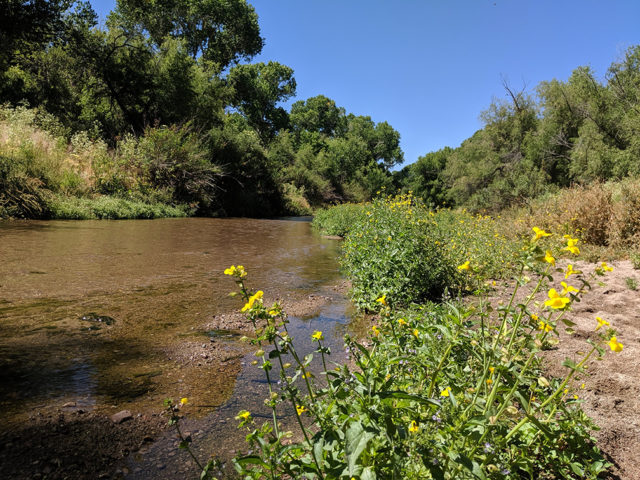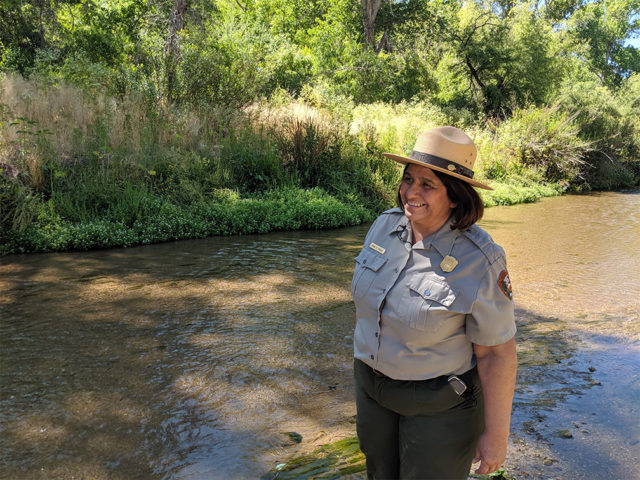“It is true that time has deteriorated the bridge, just as the river’s flow has weakend beneath it. But it’s also true that Santa Cruz River is coming back.”
—Diana Madril, Tumacácori resident

Strolling along Santa Gertrudis Lane in Tumacácori, Diana Madril points out a large cement structure that is set back from the road and disappearing beneath an overgrowth of vegetation. It would be an easy site to miss, compared to nearby attractions like the de Anza Trail and the Santa Cruz River, but this cement ruin means something more to Diana. It was once a pedestrian bridge that spanned the wide Santa Cruz River, and Diana used to walk across this bridge to visit her grandmother on the other side. The bridge has been partially removed and is now almost completely forgotten; the river is no longer wide enough to need it.
Diana grew up in Tumacácori Village, and she remembers when the river was a much bigger part of life in her community. “The river always had water. Now there are times when there’s no water. We used to come to play down by the river. We used to go build forts there. We’d play all day long until it was dark. We didn’t worry about what was in the river. I don’t think my parents worried about it.”
Those new to the area would never know how much the river has changed. Most see the river as a rare source of flowing water in an otherwise arid landscape, a ripe opportunity for life to take hold. Still, Diana regards the river with an expression of disappointed nostalgia. “Before, the stream used to be really wide, from bank to bank. And now . . . it’s just . . . smaller. Not very wide at all. When it rains, we’ll come down to see how far the water is, but it’s not really. . .”
“A lot of the locals used to go to the river, all the time,” she says.“There was always somebody at the river having a picnic. I don’t think that happens so much anymore.”
—Diana Madril, Tumacácori resident
Her thoughts taper off as she tries to compare the present to the past. The wide, life-giving river of her childhood just doesn’t have the same presence here anymore. “A lot of the locals used to go to the river, all the time,” she says. “There was always somebody at the river having a picnic. I don’t think that happens so much anymore.”

Do locals still care about the river and its future? Could the stark contrast between present-day river conditions and the indelible, collective memories of a once-flowing Santa Cruz River make it even harder to protect what we still have?
Diana stands closer to the water for a photograph, and as she looks down, her face brightens. She points eagerly at the water and starts to speak more quickly., and says, “Oooh! Look at all the little tadpoles! We used to catch these little suckers—oh how cute! See? They’re cute!”

Diana is like a kid playing by the water again. She continues to tell stories about how much the river has changed over the years, but this time her tone is different, and one can’t help but believe that discovering the tadpoles has lifted her spirits just a little.
“The sad thing is when you live in an area so long there is just so much that you just take for granted. You don’t think about it because you live there your whole life…It’s important to know where you come from and where you belong.”
—Diana Madril, Tumacácori resident
Until 2009, when upgrades to the wastewater treatment process improved water quality, tadpoles and other creatures were not able to survive in the Santa Cruz River. Now, the water has improved enough to allow a diversity of aquatic life to begin to thrive again in the river. But change happens slowly, and it is easy to miss.
“The sad thing is when you live in an area so long there is just so much that you just take for granted. You know? You don’t think about it because you live there your whole life. You go with the flow. You go with the changes.” She adds, “It’s important to know where you come from and where you belong.”

©Bill Hatcher/Sonoran Institute, 2020
On the way back home from the river, the old bridge stands out a bit more clearly this time. It is true that time has deteriorated the bridge, just as the river’s flow has weakened beneath it. But it’s also true that the Santa Cruz River is coming back. Small discoveries like today’s tadpoles are how we measure that progress. Perhaps, in her grandchildren’s lifetime, Diana’s bridge will be needed again. If we keep working to protect and understand the river, then maybe one day, instead of regretting the past, we’ll be proud of how far we’ve come.
This post is part of a series of community voices about the Santa Cruz River.
Read the other posts by clicking the links in the introduction: When You and the River Meet
Blog series by Amanda Smith, Program Coordinator.
Copy-editing and audio-editing services donated generously by Nicole Cloutier and Moises Munoz.
